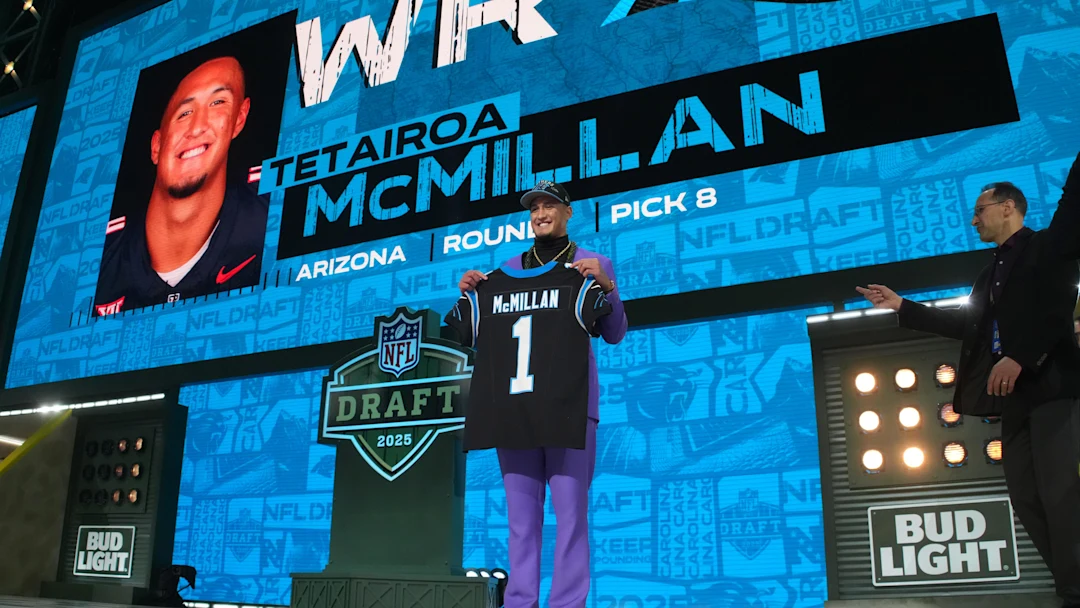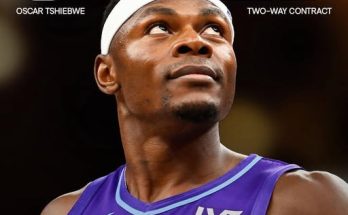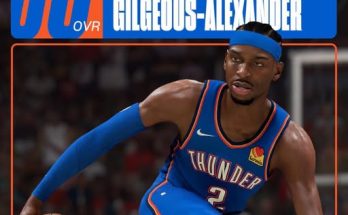The NFL is a league built on expectations, and for every breakout star, there’s a player whose hype fails to translate to production. As the 2025 season approaches, fantasy football players are eyeing potential sleepers and busts alike, and one name drawing skeptical glances from insiders is Carolina Panthers rookie wide receiver Tetairoa McMillan. Despite his impressive collegiate pedigree and undeniable physical tools, one prominent fantasy insider has sounded the alarm: don’t expect big things from McMillan this season.
McMillan, a standout at Arizona, came into the NFL with considerable fanfare. At 6’5″, with long strides, soft hands, and a knack for high-pointing the football, he looked like a prototypical NFL outside receiver. His production in college backed it up — multiple 1,000-yard seasons, a top-tier contested catch rate, and consistent performances against Power Five defenses. Panthers fans were understandably thrilled when the team selected him in the second round of the 2025 NFL Draft.
However, fantasy football is a different animal. Success on the field doesn’t always equate to fantasy relevance, especially in a team environment where opportunity, target share, and quarterback play all matter just as much as raw talent. That’s where the concern lies.
According to longtime fantasy analyst Greg Stanton, McMillan may struggle to carve out a significant role early in his rookie campaign. Stanton, who’s been breaking down fantasy trends for over a decade, recently released his “Rookie Radar Report,” where he graded incoming offensive rookies based on expected usage, scheme fit, and opportunity. McMillan ranked outside the top 15 among wide receivers — a shocking placement for a player with his physical profile.
“The talent is there,” Stanton wrote. “But we need to look at the situation in Carolina. You’ve got a second-year quarterback still learning the ropes, a crowded WR room with veterans and other young pass-catchers competing for targets, and a new offensive coordinator trying to install a system. It’s a lot for a rookie to overcome, even one with McMillan’s upside.”
Indeed, Carolina’s offense remains a question mark. Second-year quarterback Bryce Young showed flashes of growth late last season, but overall struggled through a rough rookie campaign. While the Panthers front office has made efforts to improve the offensive line and provide better weapons, it remains to be seen whether the unit as a whole can elevate itself to even league-average levels.
Additionally, McMillan enters a receiver room that isn’t devoid of talent. Veterans like Adam Thielen still have the trust of the coaching staff, and 2024 mid-round pick Jonathan Mingo has started to develop a rapport with Young. Free-agent addition Josh Reynolds also brings experience and reliability. For McMillan to carve out a meaningful target share, he’ll have to outperform these names in training camp and preseason — something that’s possible, but far from guaranteed.
Beyond personnel, scheme and coaching philosophy play a key role in how quickly rookies can make an impact. The Panthers hired former Rams assistant Brian Coen as offensive coordinator in the offseason, and while his system is expected to be creative, it’s also notoriously complex. Rookies often face a steep learning curve in systems that emphasize timing, motion, and versatile route trees.
Coen has spoken highly of McMillan’s football IQ in early offseason programs, but praised does not necessarily mean targets. Historically, rookie receivers — even elite ones — often take time to acclimate to the speed and complexity of NFL defenses. In 2024, only a handful of rookie wideouts cracked the top 30 in fantasy scoring, with most finishing as WR4s or worse.
Stanton’s analysis also leaned heavily on historical context. Over the past five years, only 30% of second-round rookie wide receivers have finished their debut seasons with more than 600 receiving yards. When those receivers are in offenses with bottom-half quarterback play or unstable coaching situations, the odds shrink further.
Fantasy managers who were hoping for an instant return on their investment in McMillan may need to recalibrate. Early ADP (Average Draft Position) data shows McMillan being taken in the double-digit rounds in redraft leagues, and often as a late flyer in best-ball formats. That’s not necessarily a bad investment, given his long-term upside, but relying on him as a weekly starter in 2025 is a gamble most insiders are hesitant to take.
Of course, not all is doom and gloom. McMillan’s ceiling remains high, and his skill set is uniquely suited to red-zone production — a quality that could earn him fantasy relevance in touchdown-dependent formats. If he can develop chemistry with Bryce Young quickly, especially in end-zone packages, there’s a path to fantasy viability even with modest yardage totals.
It’s also worth considering that Carolina’s WR pecking order is far from set in stone. Adam Thielen is aging and has seen his efficiency dip. Mingo is still unproven. And Reynolds, while steady, isn’t likely to dominate targets. If McMillan impresses early in camp and earns the trust of the coaching staff, his role could expand faster than some anticipate.
Still, Stanton and other insiders remain cautious. “I’m not fading McMillan long-term,” he emphasized. “In dynasty formats, I love the talent. But in redraft leagues? I just don’t see the consistent weekly volume needed to justify starting him unless there’s an injury ahead of him or a massive preseason breakout.”
Therein lies the distinction: dynasty players can afford to be patient, letting McMillan develop over the course of a year or two. But redraft managers — especially those in competitive leagues — need consistent production, and with McMillan’s current role uncertain, his fantasy appeal takes a hit.
Training camp and preseason will tell us more. If McMillan flashes in joint practices or catches a couple of touchdowns in exhibition games, his stock could rise in a hurry. But barring those developments, he’s likely to begin the season as a depth piece on fantasy rosters — a name to monitor, not a player to rely on.
The situation also serves as a reminder to fantasy managers not to chase upside blindly. Rookie hype is a powerful force, especially when fueled by highlight reels and glowing college stats. But as every veteran fantasy player knows, context is king. Talent matters, but opportunity, scheme, and quarterback play matter just as much — sometimes more.
McMillan’s journey is just beginning, and there’s every chance he will eventually develop into a WR1 for the Panthers, both on the field and in fantasy football. But for now, caution is warranted. Until his role becomes clearer and Carolina’s offense shows signs of stability, McMillan remains more of a long-term investment than an immediate asset.
Fantasy players should keep him on their watch lists, stash him in deeper leagues, and monitor camp reports closely. But if you’re drafting in redraft leagues with hopes of McMillan being a weekly flex option or more, it may be time to adjust those expectations. As Greg Stanton and others have made clear, 2025 might not be Tetairoa McMillan’s fantasy breakout year — but that doesn’t mean it won’t come eventually.



